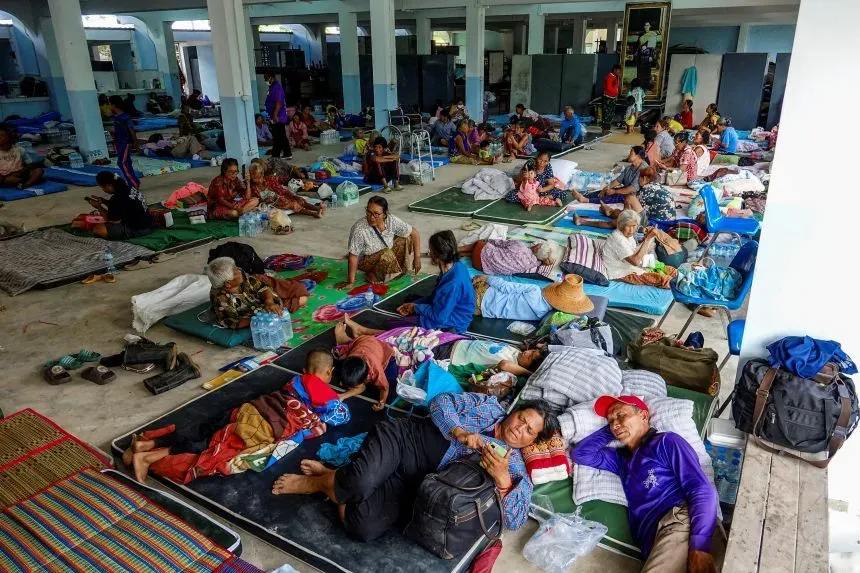The recent Thailand Cambodia border clashes have drawn significant attention as tensions escalate between the two neighboring nations. With both countries relying heavily on tourism—contributing 12% and 9% to their respective GDPs—analysts warn that the impact could be dire. While Thailand’s popular travel destinations remain unscathed, Cambodia’s tourism sector, still developing in comparison, faces substantial economic vulnerability. In this intricate geopolitical landscape, understanding the implications of the border conflict is crucial for evaluating Thailand Cambodia relations and their overarching effect on Southeast Asia tourism. As the situation unfolds, the potential dangers for Cambodia’s economy amplify, raising concerns about the future of both nations’ tourism industries amidst unrest.
In light of the ongoing military confrontations along the border, it is essential to explore the ramifications of this escalating conflict between Thailand and Cambodia. These clashes not only highlight the fragile nature of regional security but also underscore how intertwined the economic futures of these countries are. Observers note the significant contributions of the tourism industry to both nations, with potential ramifications for Cambodia’s already vulnerable economic stance. As these border skirmishes raise alarms about stability in Southeast Asia, the interaction between national tensions and tourism can no longer be overlooked, particularly with fluctuations in travel confidence that threaten livelihoods in both countries. Thus, a deeper analysis of this developing situation can shed light on the pressing issues facing the tourism sectors and their broader economic implications.
Impact of Thailand-Cambodia Border Clashes on Tourism
The ongoing Thailand-Cambodia border clashes have sparked widespread concern regarding their impact on tourism, a critical sector for both nations. In 2024, tourism made up about 12% of Thailand’s GDP and 9% of Cambodia’s, highlighting its importance for economic stability. While Thailand enjoys a well-established tourism infrastructure, the current unrest can still shake the confidence of international travelers. As tourists become wary of potential conflict, even destinations far from the border could experience decreased visitor numbers, affecting local economies reliant on tourism spending.
Cambodia’s reliance on tourism is particularly precarious given its emerging status as a travel destination. Analysts point out that any sustained unrest could derail the momentum Cambodia has built in attracting international visitors. With only 6.7 million tourists in 2024 compared to Thailand’s 35 million, the economic vulnerability of Cambodia becomes pronounced. The potential for diminished travel confidence due to the clashes could lead to significant financial losses, exacerbating pre-existing economic issues.
Economic Vulnerability in Cambodia Amidst Tensions
As the border conflict escalates, Cambodia is projected to face greater economic vulnerability compared to Thailand. Analysts note that Cambodia lacks the fiscal reserves and comprehensive tourism promotion strategies that Thailand possesses. Such limitations hinder the Cambodian government’s ability to respond effectively to short-term tourism downturns caused by the clashes. This disparity directly impacts Cambodia’s capacity to sustain its tourism sector during crisis periods, increasing the potential for long-lasting economic repercussions that could outlive the immediate conflict.
Moreover, many tourists traveling to Cambodia are motivated by cultural heritage and natural beauty. The ongoing border tensions might not only deter new visitors but also diminish the confidence of repeat travelers who contribute significantly to the economy. As Cambodia attempts to develop its tourism industry further, negative public perception stemming from conflict could hinder its growth trajectory, making the situation dire for local businesses that depend on an influx of visitors.
Thailand’s Tourism Resilience During Border Tensions
Despite the rising border tensions, Thailand’s tourism sector appears to be more resilient. With key tourist destinations situated far from the areas affected by the clashes, the country is well-positioned to maintain a steady influx of international visitors. Analysts believe that Thailand’s established reputation and robust tourism infrastructure provide a buffer against the immediate adverse effects of military conflict, enabling it to weather the storm more effectively than Cambodia. The variety and volume of tourism offerings in Thailand create a protective layer for the economy.
Additionally, Thailand can leverage its substantial fiscal buffers to promote tourism in the wake of declining travel confidence. The government’s capacity for launching strategic marketing campaigns aimed at reassuring potential travelers could mitigate economic losses. Therefore, while the border clashes present challenges, Thailand’s tourism sector is equipped with necessary tools to navigate through the instability, striving to maintain its status as a leading destination in Southeast Asia.
Analysis of Border Conflict and its Broader Implications
The Thailand-Cambodia border clashes are emblematic of broader regional tensions in Southeast Asia, raising critical questions about national security, bilateral relations, and economic stability. A comprehensive border conflict analysis indicates that while both nations may suffer from the fallout, it is Cambodia that bears the brunt of the economic repercussions. The precarious nature of Cambodia’s economy, in contrast to Thailand’s more robust framework, presents significant risks if these tensions persist.
Furthermore, the potential for regional instability poses challenges not only for the immediate countries involved but also for neighboring nations and international stakeholders. The United States has expressed concern over the escalating situation and has called for de-escalation—a sentiment echoed by various analysts. Efforts towards constructive dialogue and conflict resolution will be essential to prevent further deterioration of relations and to stabilize the economic landscape of both countries within Southeast Asia.
Future Prospects for Thailand-Cambodia Relations
Looking ahead, the future of Thailand-Cambodia relations hangs in a delicate balance influenced by current events. Understanding the economic impacts of the border clashes is crucial for both governments as they navigate the complexities of nationalism and military operations. While mutual economic interests could catalyze negotiation efforts, the road to reconciliation will not be straightforward. Historical tensions and recent developments complicate prospects for a rapid turnaround in diplomatic relations.
Analysts remain cautiously optimistic about the potential for de-escalation and improved relations if both countries can find common ground amidst the turmoil. The shared recognition of the significant role that tourism plays in their economic development may serve as a unifying factor. Collaborative initiatives focusing on tourism recovery and economic stability might empower both nations to emerge stronger from the current challenges.
Role of ASEAN in Mediating Thailand-Cambodia Conflict
In the midst of the escalating conflict, the role of the Association of Southeast Asian Nations (ASEAN) has become increasingly pertinent. ASEAN has historically embraced principles of non-interference and dialogue, which could be essential for mediating the tensions between Thailand and Cambodia. With tourism a central pillar of both nations’ economies, ASEAN’s involvement could facilitate discourse aimed at de-escalating the border clashes and fostering cooperation.
Moreover, ASEAN’s regional focus on economic integration and stability can help both nations navigate the complexities of the current conflict. By leveraging its collective influence, ASEAN could promote initiatives that bolster tourism and economic collaboration, potentially reducing the adverse impacts of the clashes. A united front may also serve as a powerful message to the international community regarding the importance of peace and stability in the region.
Tourism Strategies Post-Conflict: Recovery Plans for Cambodia
Post-conflict recovery plans for Cambodia’s tourism industry will be critical for restoring confidence among prospective visitors. Analysts suggest a proactive approach involving the Cambodian government and local stakeholders in developing robust strategies to counter the negative perceptions brought on by the border clashes. Strategic marketing promoting Cambodia’s rich cultural heritage and natural attractions could enhance its appeal and encourage tourist footfall once stability is restored.
Additionally, establishing partnerships with international tourism organizations and leveraging digital platforms for outreach can aid in rebuilding Cambodia’s tourism sector. By creating a narrative of resilience and safety, Cambodia may be able to attract travelers seeking unique experiences even in the wake of regional challenges. Prioritizing sustainable tourism initiatives will not only support immediate recovery but also enhance long-term economic resilience.
International Response and its Effects on Southeast Asia Tourism
The international response to the ongoing Thailand-Cambodia border conflict has implications that reach far beyond the immediate region. Calls from nations such as the United States for de-escalation reflect growing global concern about instability’s impact on Southeast Asian tourism as a whole. Countries that are economically intertwined, like Thailand and Cambodia, need to consider the effects of their actions not just locally, but within the greater context of regional dynamics and international relations.
If tensions continue to escalate, other Southeast Asian nations may experience secondary effects, such as diminished regional tourism flows and economic instability. Strong diplomatic efforts and international mediation could prove essential to stabilize the situation, easing fears of conflict and reinvigorating confidence thereby benefiting the entire region. A collaborative approach towards addressing tourism and economic vulnerabilities could establish a framework for lasting peace and cooperation among nations in Southeast Asia.
Addressing Nationalism and Its Impact on Thailand-Cambodia Relations
As nationalistic sentiments heighten amid the ongoing border clashes, addressing these sentiments is crucial for both Thailand and Cambodia. The interplay of nationalism can lead to a hardened stance from both governments, complicating efforts toward peaceful resolutions. However, understanding these dynamics could present opportunities for dialogue and reconciliation that prioritize mutual economic benefits, especially in the tourism sector.
Efforts to promote cultural exchange and awareness between the two nations may mitigate nationalistic fervor and foster a sense of collective identity. By prioritizing shared heritage, economic collaboration, and tourism initiatives that benefit both countries, the potential exists for overcoming the tensions of the present and building stronger bilateral relations. A commitment to de-escalation could open doors to constructive engagement that reinforces Southeast Asian unity.
Frequently Asked Questions
How are the Thailand Cambodia border clashes affecting Thailand’s tourism?
The Thailand Cambodia border clashes pose minimal risks to Thailand’s tourism, as most tourist destinations remain unaffected by the conflict. Although the tensions could dampen travel confidence, analysts believe that Thailand’s robust tourism infrastructure and established industry will help mitigate immediate economic impacts.
What is the economic vulnerability of Cambodia due to the Thailand Cambodia border clashes?
Cambodia’s economy is more vulnerable to the Thailand Cambodia border clashes because tourism serves as a significant economic driver, constituting about 9% of its GDP. The ongoing conflict not only threatens to deter tourists but also puts additional strain on Cambodia’s tourism sector, which lacks the policy tools available to Thailand to navigate such crises effectively.
What lessons can be learned from the border conflict analysis between Thailand and Cambodia?
The border conflict analysis indicates that both nations are likely to suffer economically due to warfare; however, Cambodia’s tourism-dependent economy may face more devastating consequences. Analysts emphasize the need for improved diplomatic relations and conflict resolution mechanisms to safeguard the interests of both countries.
How does the Thailand Cambodia border conflict impact Southeast Asia tourism overall?
The Thailand Cambodia border conflict may create a ripple effect on Southeast Asia tourism by impacting regional stability. As travelers remain cautious about visiting conflict zones, surrounding countries could also experience declines in visitor numbers, especially those promoting cross-border tourism.
What steps can Thailand and Cambodia take to improve their relations amid ongoing border clashes?
To improve Thailand Cambodia relations amidst the ongoing border clashes, both governments could engage in diplomatic dialogue and explore mutually beneficial agreements. Collaborative efforts aimed at enhancing tourism cooperation and stability in the border regions could promote a more peaceful coexistence.
| Key Point | Details |
|---|---|
| Tourism Contribution | Thailand: 12% of GDP; Cambodia: 9% of GDP in 2024 |
| Vulnerability to Conflict | Cambodia’s tourism industry is more vulnerable to impacts from border clashes than Thailand’s due to its less established status. |
| Recent Clashes | On July 24, 2025, there were exchanges of gunfire across the border, resulting in at least 11 civilian deaths. |
| Economic Impacts | Thailand’s tourism disruption from conflict is predicted to be less severe; popular tourist destinations are further from fighting. |
| Potential for De-escalation | Despite the tensions, there are concerns about nationalistic sentiments complicating de-escalation efforts, but there is cautious optimism. |
Summary
The Thailand Cambodia border clashes have raised serious concerns about the future of both nations’ economies, particularly in regard to tourism. Analysts emphasize that while both economies are heavily reliant on tourism, Cambodia’s less established industry could face greater risks due to the recent conflicts. The ongoing tensions and military actions are likely to affect travel confidence, which is essential for tourism-dependent regions. As both countries navigate these challenges, the hope for a peaceful resolution remains crucial for stabilizing their economies.



